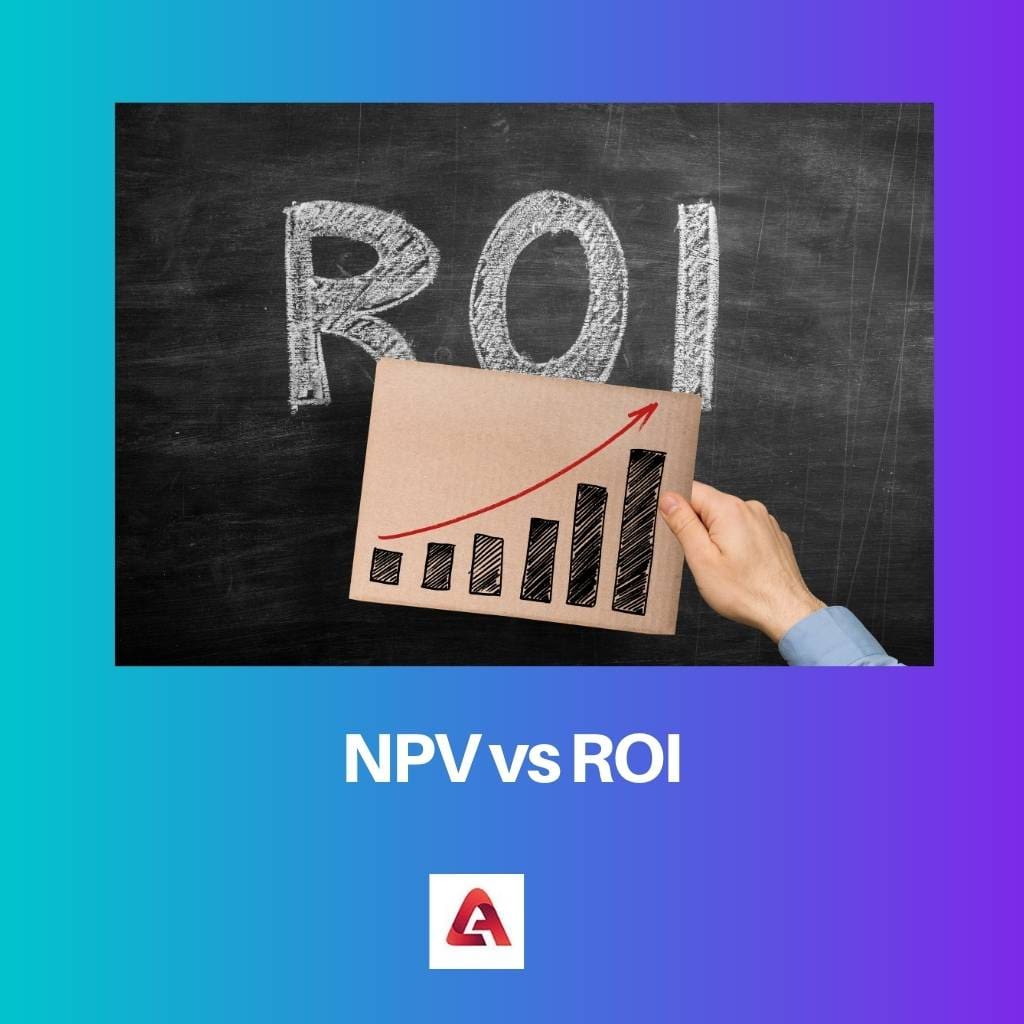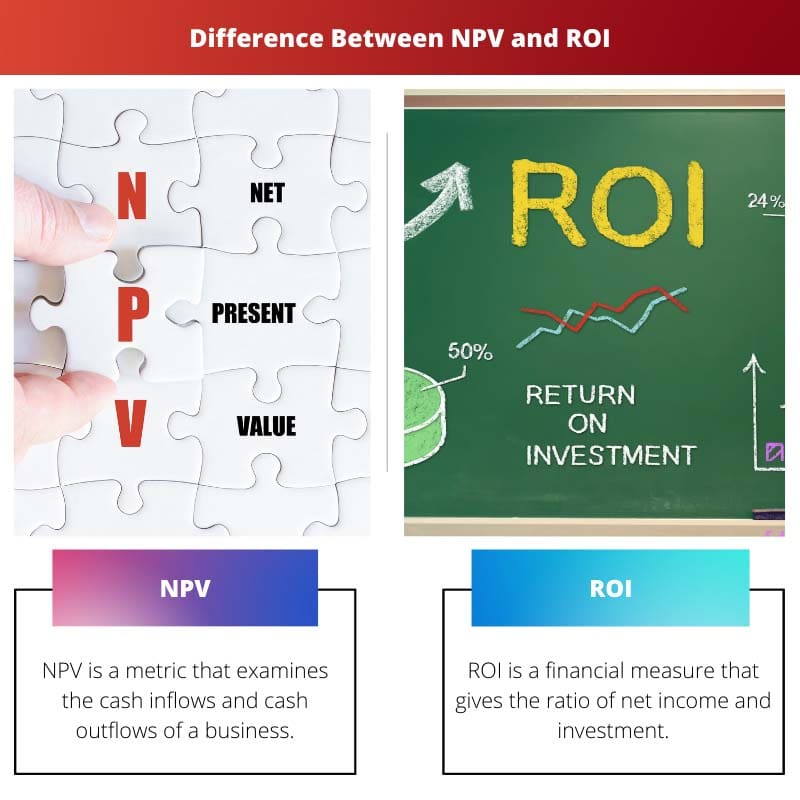Financial metrics are used to calculate and see the result of the investments or the cash flow for different types of institutions. Some of them are more commonly used than others. The choice depends on what the owner wants to get information on.
Both NPV and ROI are terms that are very common and useful in the business and finance world. If one is starting a new company or enterprise, one should be able to distinguish between various terms used in calculating the business results.
Key Takeaways
- NPV, or net present value, is a financial calculation used to determine the current value of an investment based on expected future cash flows.
- ROI, or return on investment, is a measure of the profitability of an investment, calculated as a percentage of the initial investment.
- While NPV considers the time value of money and provides a dollar value for an investment, ROI is a simpler calculation that can compare the profitability of different investments.
NPV vs ROI
Net Present Value, or just NPV, is a financial metric used to evaluate investment projects. NPV measures the present value of expected future cash flows. Return on Investment, or ROI, is a percentage that measures the profitability of an investment by dividing the net profit by the investment cost.

NPV provides the net present value of the current cash flow of a business. The resulting amount might either come in a positive amount or in a negative one.
If the total comes off as negative or unfavourable, then it means a low return. During the calculation, investments are discounted according to the present day.
ROI is a financial measure used to measure the amount of profitability on the amount of invested cash flow. After the calculation, one can differentiate between profitable and unprofitable investments.
There are a few ways on how the metric can be calculated, and it depends on the requirement of the company.
Comparison Table
| Parameters of Comparison | NPV | ROI |
|---|---|---|
| Extension | Net Present Value | Return On Investment |
| Definition | NPV is a metric that examines the cash inflows and cash outflows of a business. | ROI is a financial measure that gives the ratio of net income and investment. |
| Formula | NPV= Cash flow / (1 + i)t – initial investment | ROI= (Total benefits – total costs) / total costs |
| Another name | Net present worth (NPW) | Return on invested capital |
| Advantages | Help in the planning of the business decision, regards to the time value of money, etc. | Indicates the position of investments as well as helps in the comparison of different investments, etc. |
| Disadvantages | The amount may not be totally accurate as it doesn’t add the hidden cost, etc. | The result is of a return cannot be done for a shorter amount of time period, etc. |
What is NPV?
NPV means Net Present Value. It is a financial measure used to calculate the difference between cash inflows and the cash outflows that are presently invested in the business. It basically tells how profitable a project or an investment is.
It helps the management or the owners to see which investments are fruitful and which are not. The result can come off in three situations first, where the NPV is positive.
Then, a negative NPV and, lastly, a zero NPV. Mostly, the first two are the common results. Zero NPV means that there is equality between the asset and its worth.
A positive NPV means that the investments are beneficial for the government. It is very common in the process of capital budgeting and is done after a certain period of time. The tool is not as complicated as others used for profitability calculation.

What is ROI?
ROI is a performance measure that is used to see the return on the investment(s) made on the business. Its full form is Return on Investment. The ending result comes in a ratio and percentage that differentiates it from other measures.
It is easier than other calculating metrics and, thus, is one of the most common measures to be used by people. There are many ways to calculate ROI. One way would be: Current Value of investment – Cost of investment) / Cost Of investment.
The end result can come off as high or low. A high ROI is favourable for the business, whereas a low ROI is not considered good. There are a few disadvantages of the metric, though. For example: Sometimes, the outcome cannot be accurate for long-term investments.

Main Differences Between NPV and ROI
- They have different meanings. NPV is the amount of the present value of any type of investment in a financial institution, while ROI calculates the return on the capital that is invested.
- The result of NPV comes in an absolute number. On the flip side, ROI is a percentage.
- Both of the metrics are used to determine different estimations. NPV is used to get the present value of the assets, basically to judge if they are viable or not. ROI, on the other hand, is calculated so that one can measure and compare different investments of the company.
- Since NPV is based on the assumptions made for the future, it can affect the result of the end amount in error. In contrast, there are fewer errors in the calculation of ROI since it doesn’t depend on estimations of the future.
- During the calculation of NVP, the risk is factored in. On the other hand, there is no risk factor involved in ROI. It comes in use after a certain time period if the user wants to use it, otherwise not.
- NVP is time-adjusted, while in comparison, ROI is not.

- https://books.google.co.in/books?id=UQT0AMDZ3w4C&pg=PA98&dq=npv+and+roi&hl=en&sa=X&ved=2ahUKEwiE6ua-l8fxAhWzoekKHTo0CTsQ6AEwBHoECAwQAw#v=onepage&q=npv%20and%20roi&f=false
- https://books.google.co.in/books?hl=en&lr=&id=m7CWxNx53h8C&oi=fnd&pg=PR6&dq=info:u9f3a4_JRtEJ:scholar.google.com/&ots=8c4ctK0VzT&sig=Q66v40LxdbYSvKJCmEXKnQWnptA&redir_esc=y#v=onepage&q&f=false




